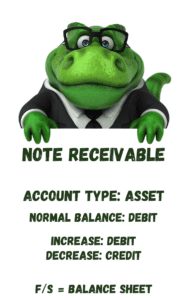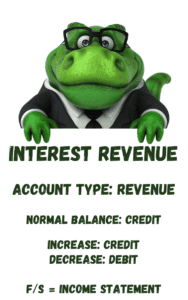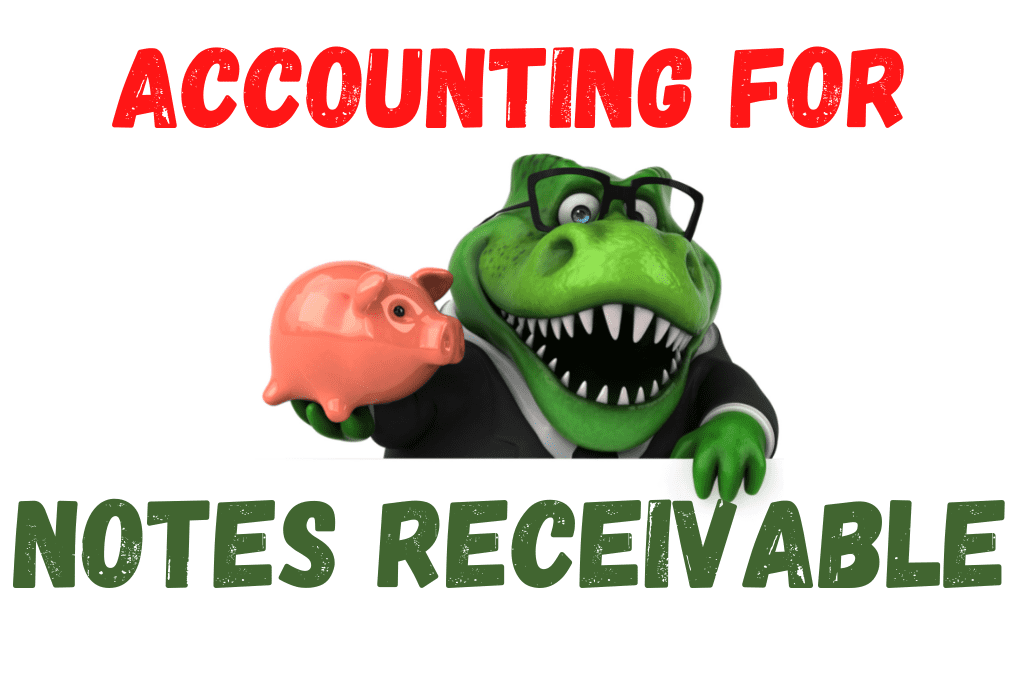What is a Note Receivable?
A note receivable is formal payment agreement between two or more people or entities. It is a promissory note that specifies:
- Who the note is due to (the payee)
- Who the note is due from (the maker)
- The amount due (the face value)
- The date the note was issued
- The date the note will be paid (the due date or maturity date)
- The term of the note (the amount of time between the date of issue and the maturity date)
- The interest rate that will be paid on the note.

What Type of Account is Notes Receivable?
Notes Receivable is an Asset account. For Notes due in less than one year, Notes Receivable accounts are listed in the Current Asset section of the Balance Sheet. Notes Receivable due in more than one year are listed in the Long-term Asset section of the Balance Sheet.
What is the Normal Balance of Notes Receivable?
Notes Receivable is an Asset account so it has a normal debit balance. Notes Receivable is increased on the debit (left) side of the account and decreased on the credit (right) side of the account.
What is the Difference Between Notes Receivable and Accounts Receivable?
Accounts Receivable is a normal business transaction for between a company and its customer. The intent is for the debt to be settled in the normal course of business, usually in 30 days (depending on the terms of the account.) It typically does not have an interest rate. It may carry a finance charge or late fee if not paid within terms.
A Note Receivable is a more formal agreement and carries interest. It has a stronger legal claim than Accounts Receivable, meaning it is more likely to get paid than Accounts Receivable if the maker enters bankruptcy.
In some instances, an Accounts Receivable amount may be changed to a Note Receivable by agreement between the company and the customer. This is usually done to give the company a more formal agreement with a customer with an overdue balance.
What is the Difference Between a Note Receivable and a Note Payable?
A Note Receivable is recorded when a company is on the “receiving” side of a debt. A Note Payable is recorded when a company is on the “paying” side of a debt. Every Note Receivable has both a receiving party and a paying party. Every Note Payable has both a receiving party and a paying party. The difference in recording is based on which side of the transaction a company is on.
For example:
Company A owes money to Company B. Company A has a Note Payable. Company B has a Note Receivable.
How is Interest on a Note Receivable Calculated?
Interest on a Note Receivable is calculated using the following equation:
Interest = Principal x Rate x Time
Principal is the face value of the note. Rate is the interest rate applied to the note. Time represents the number of days (or other time period assigned) from the date of issuance of the note to the date of maturity of the note.
For example, a $10,000 face value, 30-day Note Receivable at 5% interest rate is issued on January 1. The 30 day time period starts on the day after the issuance date. This means the note matures (comes due) on January 31. The time period of a note is stated as a number of days of the total year (for example, 30 days of 360. See note below.)
The interest calculation for this note is:
$10,000 (principal) x 5% (interest rate) x (30/360) (number of days divided by number of days in the year)
Interest on this note is $42 (rounded for simplicity)
Note that some textbooks use 360 days in a year, and some textbooks use 365 days in a year. Using 360 days is a throwback to the very olden days when “calculators” were people who calculated. 360 is easier for manual calculations.
How is Interest on a Note Recorded?
Interest on a Note is generally recorded at the time the interest is earned. For a 30 day note that falls within one accounting period (a month), the interest is recorded at the time the note matures with the interest being recognized as revenue using an Interest Income or Interest Revenue account. For a note that crosses accounting periods (months or years), interest is recorded as it is earned using an account called Interest Receivable.
What Type of Account is Interest Receivable?
Interest Receivable is an Asset account so it has a normal debit balance. Interest Receivable is increased on the debit (left) side of the account and decreased on the credit (right) side of the account.

What Type of Account is Interest Income?
Interest Income or Interest Revenue is an Revenue account so it has a normal credit balance. Interest Income or Interest Revenue is increased on the credit (right) side of the account and decreased on the debit (left) side of the account. The account name used will be specified in the company’s Chart of Accounts.

When is Interest on a Note Receivable Paid?
When interest will be paid on a Note Receivable is specified in the promissory note. The note may specify that the interest is due at the maturity of the note. Or, it may specify that interest will be due at certain points during the note’s duration (monthly, quarterly, semi-annually).
What is the Journal Entry to Record the Issuance of a Note Receivable?
| Note Receivable | xx | |
| Revenue or Accounts Receivable or Cash | xx |
The account to be credited depends on what the transaction is. Are we loaning money? (Cash) Are we selling something to our customers? (Revenue) Do we have a customer that didn’t pay an amount they owed us? (Accounts Receivable)
For the purposes of accounting class, we will focus on Accounts Receivable transactions where an Accounts Receivable is turned into a Note Receivable.
But, briefly, if a bank is loaning cash (the bank’s Note Receivable) to a customer (the customer’s Note Payable), the credit would be to Cash for the bank. If a company is selling to its customer and issuing a Note Receivable rather than an Accounts Receivable, a Revenue account would be credited to record the revenue.
Notes Receivable Journal Entries Examples
Example Dino-Kleen
Dino-Kleen, a customer of Terrance Inc. owes a $10,000 invoice that is past due. Terrance Inc. agrees to grant Dino-Kleen a longer period of time to pay the invoice in exchange for 5% interest. The term of the note will be 90 days, beginning on January 1. Interest will be paid at the time the note matures. The maturity date is April 1. This means the interest on the note is earned in the January, February, March, and April accounting periods.
Journal Entry at Issuance of Note
| January 1 | Note Receivable-Dino-Kleen | 10,000 | |
| Accounts Receivable-Dino-Kleen | 10,000 |
In this journal entry, the Accounts Receivable invoice for Dino-Kleen is reduced to take the invoice out of Accounts Receivable. It will no longer appear on Accounts Receivable reports or be included in the Accounts Receivable total. In the place of the Accounts Receivable, is the new Note. We are transitioning the debt from Accounts Receivable to Notes Receivable.
Journal Entry at month end January
| January 31 | Interest Receivable | 42 | |
| Interest Revenue | 42 |
At the end of January, Terrance Inc has earned 30 days of the 90 days of interest and since the note specifies interest will be paid at maturity, a journal entry is completed to recognize the interest earned by Terrance Inc.
The interest calculation for this note is:
$10,000 (principal) x 5% (interest rate) x (30/360) (number of days divided by number of days in the year)
Interest on this note is $42 (rounded for simplicity)
This adjusting journal entry is needed to conform to GAAP, recording revenue in the month it is earned. Since cash isn’t changing hands until later, we record the amount in the Interest Receivable account to keep track of what will be due.
Journal Entry at month end February
| February 28 | Interest Receivable | 39 | |
| Interest Revenue | 39 |
On February 28 a similar entry will be made to record the interest revenue earned in February.
At the end of February, Terrance Inc has earned 28 days of the 90 days of interest and since the note specifies interest will be paid at maturity, a journal entry is completed to recognize the interest earned by Terrance Inc.
The interest calculation for this note is:
$10,000 (principal) x 5% (interest rate) x (28/360) (number of days divided by number of days in the year)
Interest on this note is $39 (rounded for simplicity)
This adjusting journal entry is needed to conform to GAAP, recording revenue in the month it is earned. Since cash isn’t changing hands until later, we record the amount in the Interest Receivable account to keep track of what will be due.
Journal Entry at month end March
| March 31 | Interest Receivable | 43 | |
| Interest Revenue | 43 |
On March 31 a similar entry will be made to record the interest revenue earned in March.
At the end of March, Terrance Inc has earned 31 days of the 90 days of interest and since the note specifies interest will be paid at maturity, a journal entry is completed to recognize the interest earned by Terrance Inc.
The interest calculation for this note is:
$10,000 (principal) x 5% (interest rate) x (31/360) (number of days divided by number of days in the year)
Interest on this note is $43 (rounded for simplicity)
This adjusting journal entry is needed to conform to GAAP, recording revenue in the month it is earned. Since cash isn’t changing hands until later, we record the amount in the Interest Receivable account to keep track of what will be due.
As of March 31, the following interest has been recorded for the note:
| January 31 | 42 |
| February 28 | 39 |
| March 31 | 43 |
| Total Interest Receivable | 124 |
This balance represents 89 days [30 days in January, 28 days in February, 31 days in March] of the the 90 day note. The note matures on day 90, April 1. Interest revenue has been recorded for 89 days out of the 90 period.
Journal Entry at maturity
At the time the note matures, the remaining interest revenue is recorded. We could do it using this journal entry:
| April 1 | Interest Receivable | 1 | |
| Interest Revenue | 1 |
The interest calculation for this note is:
$10,000 (principal) x 5% (interest rate) x (1/360) (number of days divided by number of days in the year)
Interest on this note is $1 (rounded for simplicity)
Or, we can combine this entry with the journal entry for the repayment of the note. Rather than using Interest Receivable for the one day of interest in April, we record it as part of the cash payment, skipping the step of first entering it in the receivable.
| April 1 | Cash | 10,125 | |
| Interest Revenue | 1 | ||
| Note Receivable | 10,000 | ||
| Interest Receivable | 124 |
Let’s break that journal entry down:
Cash amount equals the $10,000 face value of the amount of the note receivable plus the full amount of the interest being paid.
Interest Revenue of $1 is the remaining amount of interest Terrance Inc. earned on the final day of the note. (All other Interest Revenue was recorded during the month it was earned.)
Note Receivable amount represents the payment in full for the Note Receivable. We are reducing the amount that our books show Dino-Kleen owes us.
The Interest Receivable amount of $124 is reducing the Interest Receivable account to show that the interest has been paid.
Tips
- Revenue should always be recorded in the month earned.
- If Revenue isn’t received in the month earned, the debited account is a Receivable account (Interest Receivable).
- If Revenue is received in the month earned, the debited account is Cash.
- When the note matures (is paid), make sure all the revenue for the interest has been recorded.
- When the interest receivable is paid, reduce it by crediting it.
- When the note is paid, reduce it by crediting it.
- Cash paid will include the principal amount of the note and the interest amount due.
- Check your textbook to see whether the days used to figure interest is 360 or 365.
For more examples of Accounting for Notes Receivable, watch this video:
-
How to Know What to Debit and What to Credit in Accounting
If you’re not used to speaking the language of accounting, understanding debits and credits can seem confusing at first. In this article, we will walk through step-by-step all the building
-
How to Analyze Accounting Transactions, Part One
The first four chapters of Financial Accounting or Principles of Accounting I contain the foundation for all accounting chapters and classes to come. It’s critical for accounting students to get
-
What is an Asset?
An Asset is a resource owned by a business. A resource may be a physical item such as cash, inventory, or a vehicle. Or a resource may be an intangible
-
Difference Between Depreciation, Depletion, Amortization
In this article we break down the differences between Depreciation, Amortization, and Depletion, discuss how each one is used, and what the journal entries are to record each. The main
-
What are Closing Entries in Accounting? | Accounting Student Guide
What is a Closing Entry? A closing entry is a journal entry made at the end of an accounting period to reset the balances of temporary accounts to zero and
-
What is a Liability?
A Liability is a financial obligation by a person or business to pay for goods or services at a later date than the date of purchase. An example of a

